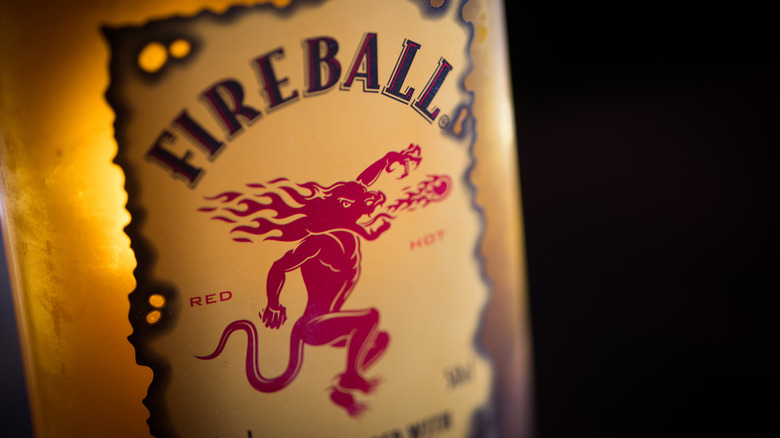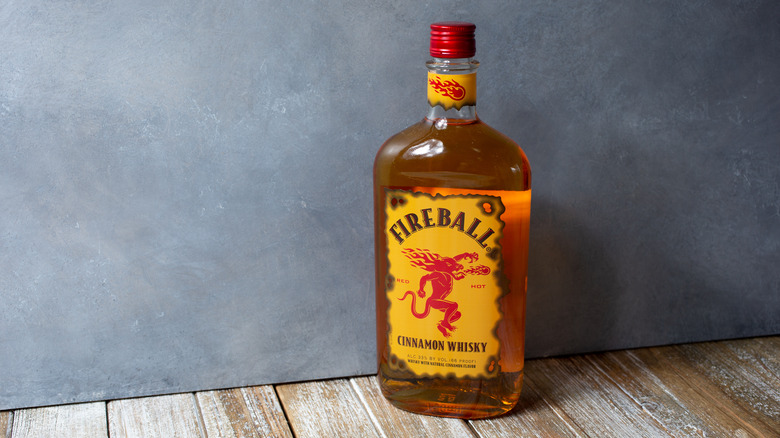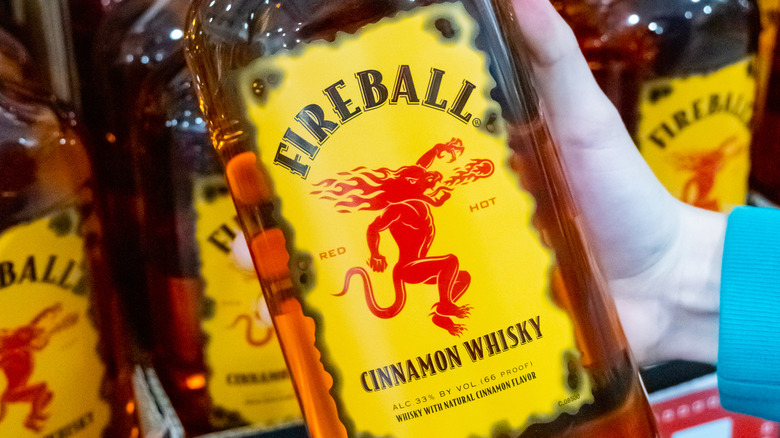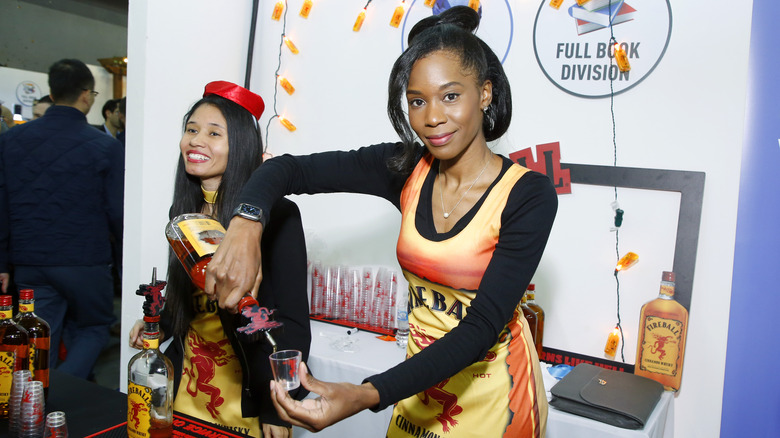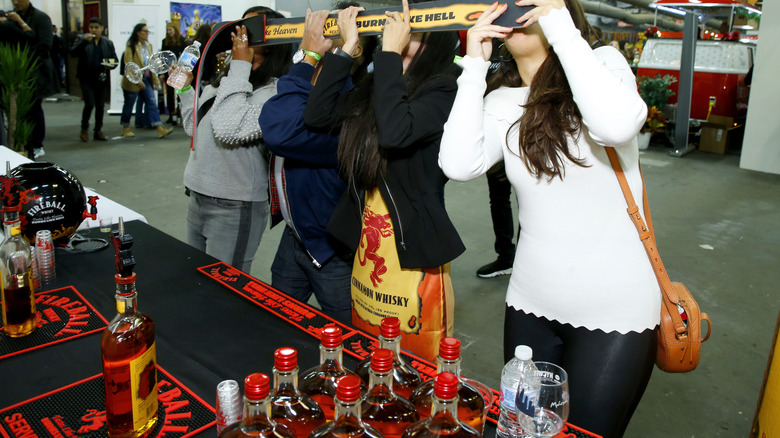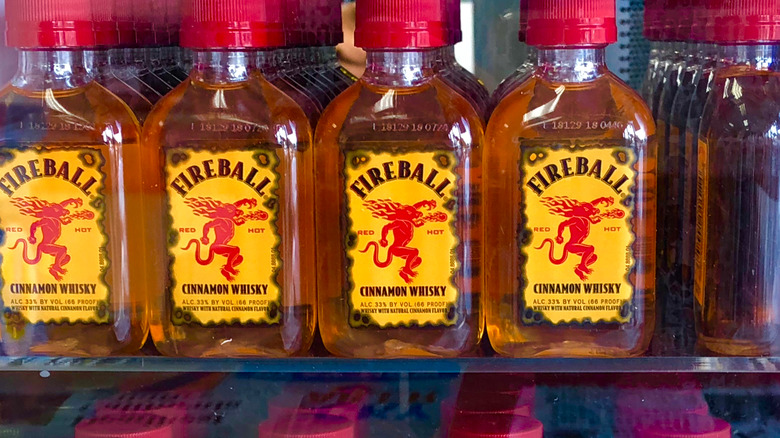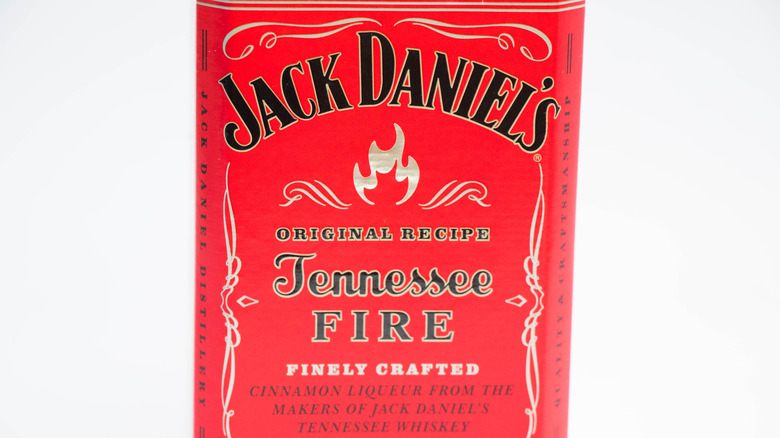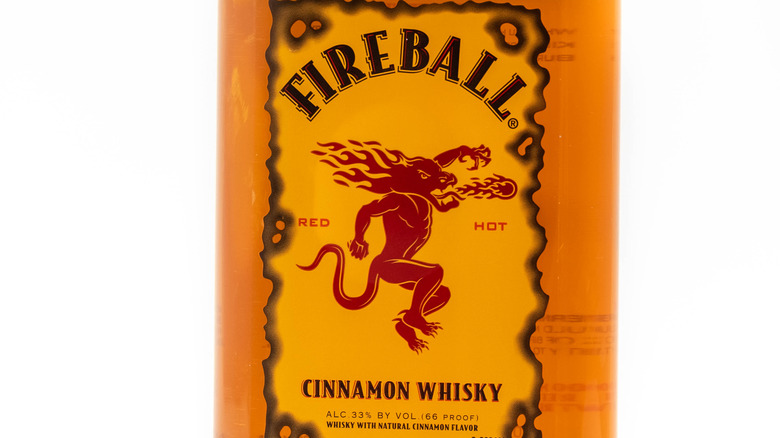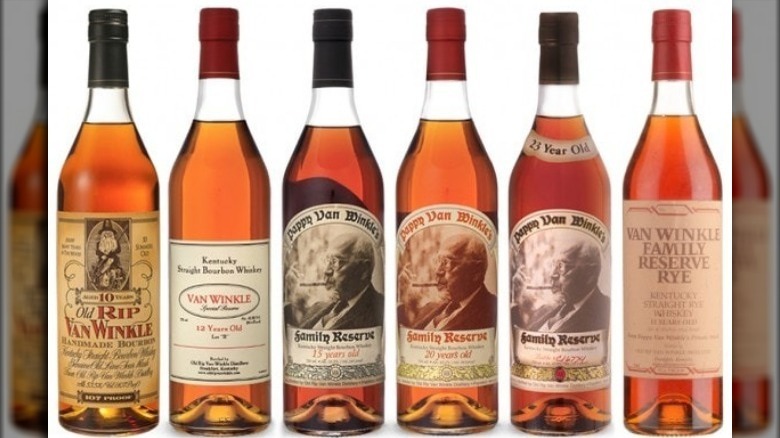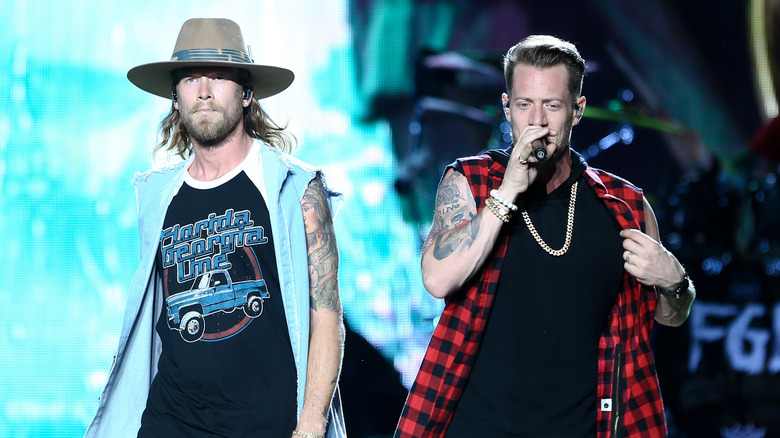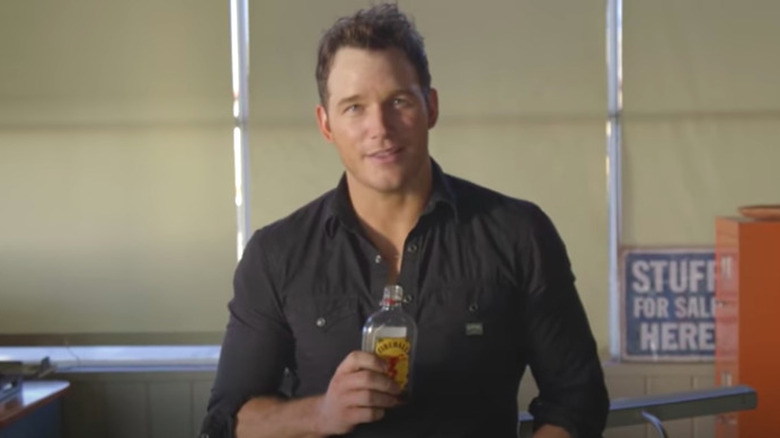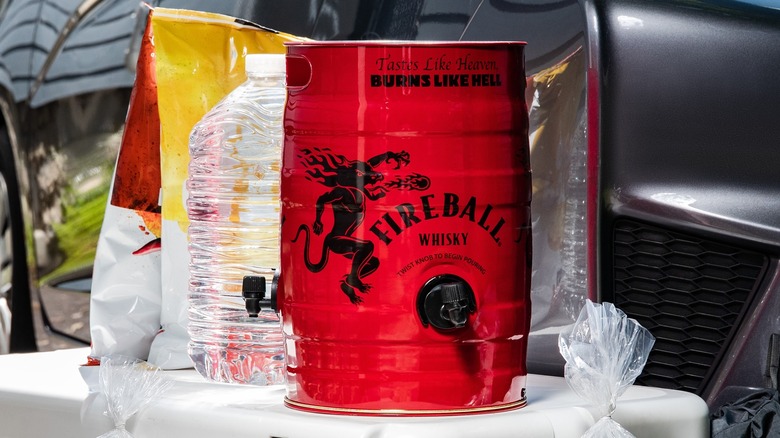The Untold Truth Of Fireball
Love it or hate it, you can't deny the fiery popularity of Fireball Cinnamon Whisky. The flavored spirit came seemingly out of nowhere to quickly become one of the most talked about — and asked for — alcoholic beverages around. So what's to be said about Fireball that hasn't been said before? Plenty, as it turns out.
Fireball is known, above all else, for its incredibly unique taste. One fan may have described the flavor of Fireball best when they told AL.com it tasted like, "Big Red in liquid form." But behind this sweet and spicy concoction is an incredible origin story that starts north of the border and continues down south to the Louisiana bayou. Along the way, Fireball has seen its sales skyrocket, but also has been the subject of controversy. From its questionable ingredients to its uber-popularity with everyone from college students to country music singers, here is the untold truth of Fireball.
It is not technically whisky
There's one thing you should know about Fireball Cinnamon Whisky before you ever open a bottle: it's not really whisky. Just about anywhere in the world, a spirit needs to be at least 40 percent alcohol by volume (ABV) in order to legally be called whisky (or whiskey, depending on what country you're in). So why is Fireball allowed to be called whisky? Regulations in Canada, where the spirit is distilled, dictate that anything labeled "Canadian whisky" must meet the 40 percent ABV threshold. There is no such rule, however, about products simply labeled "whisky." These spirits just need to be made from a whisky base. Fireball is made by adding cinnamon flavoring to traditional Canadian whisky. Therefore, it is legally allowed to be called "whisky," just not "Canadian whisky."
In the United States, meanwhile, flavored whiskey is allowed to be designated as such so long as it is at least 60 proof (30 percent ABV) and the predominant flavor is included in the name. Add all of these rules together and you now know why it's called Fireball Cinnamon Whisky.
Fireball has been around a lot longer than you think
It's easy to think Fireball is a relatively new product. But while its popularity may have skyrocketed in recent years, the spicy substance has actually been around for over 30 years. What we know today as Fireball Cinnamon Whisky was originally developed in the mid-1980s by the Canadian beverage company Joseph E. Seagram & Sons. It was known back then as Doctor McGillicudy's Fireball Whisky, part of a product line of flavored schnapps that still exists today. (Doctor McGillicudy was a completely fictional person, in case you're wondering.)
For many years, the cinnamon liqueur was primarily sold north of the border. In 1989, the American-based Sazerac Company purchased the rights to the entire Doctor McGillicudy line of spirits and attempted to increase sales in the United States. As part of an advertising stunt, Sazerac paid a town in North Dakota agreed to temporarily change its name to McGillicudy City in exchange for $100,000, according to the Associated Press. While the promotion may have helped put the rural community on the map, there's no proof it helped sell any more schnapps. In fact, it would take another decade before the brand's cinnamon whisky became a household name.
Fireball became wildly popular thanks to a rebranding campaign
If it feels to you like Fireball Whisky came out of nowhere, you're right. Although the alcoholic beverage we know as Fireball has been around for decades, its name and branding are much more recent creations. After the Sazerac Company purchased the rights to what was then known as Doctor McGillicudy's Fireball Whisky in 1989, it didn't alter much of anything about the liqueur.
That all changed in 2007 when the company rebranded the drink as Fireball Cinnamon Whisky, gave it a new logo, and unleashed a cross-country, grassroots marketing campaign. As part of the sales push, company representatives visited local bars, giving away free shots, and interacting with employees on social media. "We don't go into bars and hire girls and force people to take a shot," a Sazerac company spokesman told The Huffington Post. "What we have been doing is pushing engagement with people in the industry, particularly bartenders."
Whatever they were doing, it was working — incredibly well. Fireball Whisky went from being unheard of to the drink of choice at parties and bars nationwide, all within a few short years. According to Bravo, from 2011 to 2013, Fireball sales increased by nearly $60 million, and those figures only accounted for bottle sales from retail stores, not drink purchases at bars.
Fireball is now one of the most popular spirits in America
Once Fireball got its new name and logo, it was off and running. According to the Motley Fool, sales of Fireball jumped from less than $2 million in 2011 to $131 million in 2014. The latter total made it the seventh most-popular liquor brand in the United States (via CNN). But the $131 million figure only accounted for bottle sales from the shelf, not drink purchases at bars, where Fireball was an even hotter commodity. Bar sales of the cinnamon liqueur that same year accounted for roughly $530 million in additional revenue, for an estimated sum of $863.5 million, double its total from the year before.
While Fireball isn't sneaking up on anyone these days, and it's no longer the shiny new bottle behind the bar, it's still on the rise. The Beverage Information & Insights Group reported that Fireball sales increased by nearly 8 percent from 2018 to 2019. This continued growth has established the flavored whisky as one of the most popular alcoholic beverages not just in America, but around the globe. According to VinePair, Fireball is among the world's 30 most popular spirits and the fourth best-selling liqueur, behind only Bailey's, Jagermeister, and Fernet-Branca.
Fireball was once recalled overseas
Fireball's meteoric rise hit a momentary blip several years ago thanks to some unflattering headlines coming out of Europe. In October 2014, Norway, Sweden, and Finland recalled the liqueur for having excessive levels of propylene glycol, an ingredient also found in antifreeze. Fireball's slogan, "Tastes like heaven, burns like hell" quickly took on a whole new meaning.
It turns out the whole ordeal was much ado about nothing. Unbeknownst to most, propylene glycol is commonly used as a flavor enhancer in food and drinks. Although propylene glycol has been declared safe by authorities in both the U.S. and Europe, the former allows for higher levels of the ingredient. Therefore, there are two different Fireball recipes for North America and Europe. Norway, Sweden, and Finland were shipped the wrong batch of the liqueur, which contained an illegal amount of propylene glycol and had to be pulled from the shelves. "Unfortunately, Fireball shipped its North American formula to Europe and found that one ingredient is out of compliance with European regulations," the company said in a statement at the time.
Unfortunately for Fireball, the damage was done. To this day, you'll still find people asking if the spirit contains antifreeze. The company is clearly still a little bitter about the situation. On its FAQ page, it makes clear, "Fireball does not contain any antifreeze at all, and the suggestion is ridiculous. Sadly, this is the media's way of crafting attention grabbing headlines, but it simply is not true."
Fireball's success spawned a bunch of cinnamon whiskey copycats
You know you've reached success when others start trying to copy you — and that's precisely what happened to Fireball. Not long after the spicy liqueur became a mainstay behind every bar did other spirit companies try to get in on the cinnamon whiskey trend. Some have been more successful than others. There was SinFire Cinnamon Whisky from Hood River Distillers and Stout Brewing Company's Fire Flask. Sazerac, Fireball's parent company, sued both for trademark infringement (via The Spirit Business).
Then the big boys entered the picture. In 2014, Jim Beam unveiled Kentucky Fire, a red hot cinnamon liqueur. "We've led the category in flavor innovation in recent years ... but our latest flavor certainly turns up the heat," said Chris Bauder, General Manager of Whiskies at Beam Suntory, in a press release. "We're thrilled with the initial excitement we've seen for Jim Beam Kentucky Fire and are thrilled to continue to bring new and interesting flavor options to our fans and those who are new to whiskey."
A year later, Jack Daniels introduced its Tennessee Fire cinnamon whiskey, a mix of two of the brand's preexisting spirits: Old No. 7 Tennessee Whiskey and cinnamon liqueur. According to the Los Angeles Times, it was Jack Daniel's first new flavor since 2011. Tennessee Fire didn't go unnoticed by Sazerac. The manufacturer sued Jack Daniels for allegedly using Google advertising to send users looking for Fireball to search result pages for Tennessee Fire (via The Spirit Business).
Fireball contains a crazy amount of sugar
Let's be honest — no one drinks alcohol for its nutritional value. We all know booze isn't great for our health, so if one particular drink has a few more calories or a little extra sugar, it's not going to raise many red flags. But you should know what you're getting into when you drink Fireball, because the sweetened spirit doesn't just have a little more sugar, it has a lot more.
The process of making Fireball begins with a base of Canadian whisky. Then comes the sweet stuff. This includes real cinnamon as well as sugar. Just how much sugar? One shot of Fireball (1.5 ounces) contains a whopping 11 grams of sugar. If that doesn't sound like a lot, think again. The folks at Drink Spirits put the sugar content into perspective. Those 11 grams equals 0.38 ounces, which is roughly 25% of the shot. And remember, Fireball is only 33% ABV, meaning there is almost as much sugar in the sweet liqueur as there is alcohol. All that sweetness can take a toll on your body. According to GQ, sugary drinks are more likely to cause hangovers (and less likely to provide the desired tipsy effect).
Fireball is owned by the same company as Pappy Van Winkle
Fireball was originally developed by the Canadian corporation Joseph E. Seagram & Sons. The company may be best known stateside for its ginger ale but it was once one of the largest producers of distilled spirits in the world — that is, before it started selling off its beverage businesses. In 1989, Seagram sold its line of Dr. McGillicuddy liqueurs, including what was then known as Dr. McGillicuddy's Fireball Whisky, to the Sazerac Company. The purchase also included several other Seagram brands, such as Benchmark bourbon, James Foxe Canadian Whisky, Nikolai vodka, Carstairs Blended Whiskey, and Crown Russe vodka and gin.
Sazerac, based out of New Orleans, has a nearly 400-year history and a portfolio of products nearly as impressive, one that includes Goldschlager and Southern Comfort. But its most notable product was acquired more recently. In 2002, the Sazerac-owned Buffalo Trace Distillery, makers of the eponymous bourbon whiskey, partnered with Old Rip Van Winkle to produce its line of Van Winkle bourbons. Pappy Van Winkle has since become one of the most renowned spirits in the world, known equally for its quality as it is for its scarcity. If you can find one, a single bottle can cost thousands of dollars.
Fireball is very popular amongst country music artists
Fireball's meteoric rise has made it popular with just about every demographic, from college students to their grandmas. But there may be no group of people who enjoy drinking the cinnamon liqueur, or at least singing about, more than country music artists. The whisky is name dropped in a number of country songs, including Blake Shelton's "Buzzin'" and Florida Georgia Line's "Round Here." The latter group, in particular, has a special fondness for Fireball. According to VICE, the duo regularly takes shots of the whisky on stage, so much so that the drink is "unofficially the official drink of Florida Georgia Line."
And let us not forget about Taylor Swift. The ultra-popular singer may not enjoy Fireball as much as Florida Georgia Line, but it appears as if she's been known to indulge in the cinnamon liqueur herself every so often. In 2018, Swift joined famed country music songwriter Craig Wiseman on stage at Nashville's Bluebird Café. According to the Tennessean, Wiseman told the crowd a story about an afterparty he held following the CMT Awards. When Swift arrived, she requested access to the Fireball Whisky shot room. "I got her a shot of Fireball, and then I got her another one," Wiseman said. "For the rest of the party, I would go get a shot of Fireball ... I don't even know if she took it, but it disappeared." The two laughed it off with shot of Fireball before getting back to the music.
There are several Fireball-themed viral videos
You can't reach the highest level of the popularity stratosphere these days without going viral. Fortunately for Fireball, a number of popular videos featuring the cinnamon liqueur have been widely circulated around the internet in recent years.
In 2014, a wedding invitee had the ingenious idea to strap a GoPro camera onto a bottle of Fireball. The two-minute video, which captured dozens of the ceremony's guests taking swigs from the bottle, has since been viewed on YouTube over 3.8 million times. The very next year, GQ asked actor Chris Pratt to film a video in which he provides acting advice. He chose to do so after taking several shots of Fireball, even taking one while filming. The clip has since garnered more than 2 million views on YouTube. Also in 2015, YouTube channel Observ found four grandmothers who had never tried Fireball and recorded them as they had their first taste of the cinnamon spirit. The taste test experiment has been seen by more than 5.1 million people. And if you're wondering, the grandmas seemed to be Fireball fans.
The most popular Fireball viral video, however, occurred in 2021. A TikTok user posted a video of a fishing trip. In it, one fisherman is filleting a fish and cuts away a slab of meat only to find, much to his surprise, an unopened bottle of Fireball in the animal's stomach. The astonishing clip has since been seen nearly 23 million times.
You can now buy a fireball keg
Fireball has become one of the go-to shots for partiers, meaning it's easy for a group to run out of the cinnamon liqueur. The company just recently came up with a solution to that problem. In September, the brand started selling the FireKeg, which is filled with a whopping five liters of Fireball. (For context, the largest bottle of Fireball available in stores is 1.75 liters.) For those uninterested in crunching numbers, five liters equals 115 shots of the spicy spirit, more than enough to keep you and your friends busy for quite some time. It comes with three pouring spouts to prevent any in-party jostling. The FireKeg retails for roughly $75 and is now available for purchase at retailers across the country.
The FireKeg isn't the only party-related Fireball product, however. The company also sells a pack of 30, 25-ml prepackaged shots known as Peel and Party Shots, as well as a Party Bucket of 20, 50-ml Fireball bottles.
